
Deposition Date
2023-05-24
Release Date
2023-08-30
Last Version Date
2024-11-20
Entry Detail
PDB ID:
8P5N
Keywords:
Title:
Arsenate reductase (ArsC2) from Deinococcus indicus, co-crystallized with arsenate
Biological Source:
Source Organism:
Deinococcus indicus (Taxon ID: 223556)
Host Organism:
Method Details:
Experimental Method:
Resolution:
1.50 Å
R-Value Free:
0.17
R-Value Work:
0.15
R-Value Observed:
0.15
Space Group:
P 1 21 1


